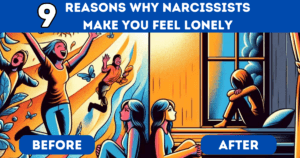Post Traumatic Stress Disorder (PTSD) directly comes from experiencing a trauma in your past. Symptoms can include flashbacks, anxiety, racing thoughts, feeling scared, overwhelming stress and depression.
PTSD doesn’t just take you back to your trauma – it re-lives it for you.
If that trauma involves narcissistic abuse – then you know exactly what it feels like to be triggered right back to the times you struggled the most, and likely many suffering – you forever wonder if this is your fate from now on.
You want and need a plan to heal, but it seems crazy to know where even to begin.
Don’t worry – we’ve got you covered.
You can begin right here.

Understand Your Innocence
Would you have knowingly and happily accepted PTSD as a part of your life if you knew what you were getting yourself into?
Narcissistic abuse is carried out by anybody with the traits who can get close enough to you to form some kind of bond that kicks the entire process off.
You were young – it was a parent. You were in love – it was a spouse. You were kind and accepting – it was a friend. You were working in a new job – it was a colleague. Where do we go to escape narcissists? We can’t.
Understanding your innocence will help you to realize that through no fault of your own – you got caught up with a narcissist – and now you are experiencing the panic and trauma.
Re-Reading The Same Chapter
Ask yourself as you begin to heal – would you pick up a book and keep re-reading the same chapter over and over again? What would happen if you did that?
Re-reading the same chapter in a book will make the words more and more ingrained into your memory. You will soon anticipate what’s coming, and what happens next.
You will also never get to the end of the book. You will never understand or appreciate the entire journey of the story, because you remain in a chapter that has been and gone.
PTSD is similar.
Going back to the past and reliving your trauma is not only detrimental to your present, but also to your future. How can you carve a path ahead when all that keeps happening is you being pulled back by the invisible, magnetic force of the abuse?
Plant a Seed of Hope
Planting a seed of hope is like giving yourself a second chance.
People who plant seeds of hope, often forget to water them. They sometimes leave their seeds dry and in a dark corner, then wonder why it isn’t growing and thriving.
We all have seeds, and we all can plant them and nurture them, but PTSD can make people feel as if they don’t. The power that comes with remembering that you do is extraordinary.
You have survived every moment of abuse you were subjected to. You have got through it all – even with pain and trauma attached – and now is the time to plant your seed of hope and shed those layers of pain that have kept you cocooned all these years.
Understand the Mind-Body
The mind and body are connected. Both are influenced by each other, so positive thoughts lead to positive feelings, and vice versa. When you become triggered by past memories, they will seem so real and vivid that your sympathetic nervous system will ignite your fight-or-flight response.
Your heart races, you pupils dilate, your immune system goes to sleep, you start to sweat, the blood is pumping.
You’re ready to fight that bear in the woods.
But wait… Where’s the bear?
There is no bear.
The memories of your abuse come back to activate the same physiological response, and over time, your body is going to be so hyper-aware that anything remotely close to what you experienced will produce the same effects.
Understanding how your body and mind work together can help you to reduce all of this.
Breathing.
Meditation.
Exercise.
Self-care.
Self-love.
It’s time to increase your happy hormones – say hello to dopamine, endorphins and serotonin.
Pull in Your Support System
Never underestimate the power family and friends can offer you. From a talk to leaning on them when you aren’t okay, it’s possible to be carried through the darkest days with reassurance from your loved ones that they are there for you when you need them.
Doing things you never got to do during those periods of abuse will also be therapeutic to you. Permit yourself to love the things they once criticized or belittled you for.
Does that take time? Absolutely.
Is it worth it? There’s no doubt about it.
Therapy vs. Self-Help
There comes a time where you may need to reach out to a therapist and get the help you need. Luckily, there are so many different paths of therapy to walk along, especially when it comes to healing from PTSD.
From cognitive behavioral therapy (CBT) to eye movement desensitization and reprocessing (EMDR), there will be a therapeutic concept that works for you, helps you notice your triggers, and works with them to lessen them.
Whether or not you choose conventional approaches to therapy, you can still offer yourself help.
This means being clued up on PTSD, learning how and why it exists (in actual fact, it exists as your body and mind are trying to protect you from what it perceives to be a present threat), and understanding how to gain emotional and mental distance from it over time.
Patience – You’ll Get There
Patience might seem like a wasted concept, but if you look a little deeper, you will see yourself effortlessly wading through its waters.
We all can dig deep for patience, and even in the toughest of times, you will appreciate what it means to give yourself a break from time to time.
Life is hard enough, without the added pressure of setting a time limit for your healing.
Go from surviving to thriving – but do it in your own time.
New Beginnings Are Possible
Healing is not linear. You won’t wake up one morning and have day after day, each getting better, before reaching the finish line.
You have to be unconditionally loyal to wanting to shed the acute symptoms of PTSD your mind and body are currently harboring. Only then can you begin to see how wonderful new beginnings are – and indeed how possible they are.
What Can You Do Today:
- Start finding a meditation that suits you. Full-body scans are great at identifying tension and trauma in the body.
- Breathe with intent. Each breath is a healing aspect of your trauma.
- Find one way to understand PTSD more. This may be through a podcast, YouTube Channel or health page.
- Practice mindfulness. Being in the present moment is one way to divert your senses from your painful past, to your peaceful present.



